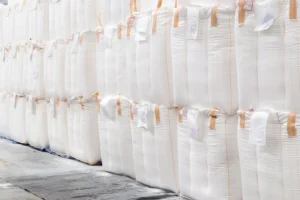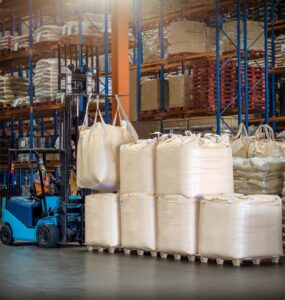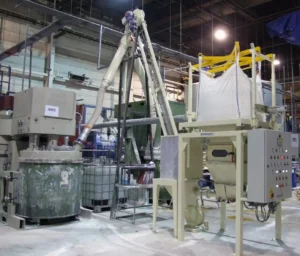We are delighted to have been entrusted to supply our highest accuracy ever ‘Spirofil’ Big Bag Filler to the world’s first industrial scale Nanotube manufacturing facility in Sambreville, Belgium. The customer, Nanocyl S.A., considered other suppliers too but Project Engineer, Michel Wattiaux, and Process Inventor, Christoph Bossout, were convinced by our guarantees of accuracy. Monsieur Wattiaux’s has also had an earlier, positive relationship with us, and our local agent, whilst working previously for a major Belgian chemical company. The order was secured with the assistance of PHC International, our experienced and well-respected agent in Belgium.
Traditionally, for most industrial applications, we offer Big Bag Fillers with weighing platforms using weigh-scales or load-cells, typically achieving accuracies of +/- 2lb. To meet the Nanocyl requirement of a weighing resolution accuracy of +/- 0.7 ounces, our engineers decided to adopt the ‘hang-weighing’ principle on this occasion and with total success. This meant that the highly sensitive load cells could be mounted high up in the structure of the filler out of harms way. Not only does the ‘Spirofil’ Big Bag Filler weigh the contents of Big Bags – it is so accurate that it also used to fill 4.5lb bags too! Accuracy is particularly critical when you are handling such a high value product.
Big bag filling takes place under a nitrogen blanket. A folded, flat bag is rigged onto the Big Bag Filler and then the bag is inflated with nitrogen. Given that the ambient air around the filler is 78% nitrogen (by volume) anyway, the displaced nitrogen is vented through a special filter unit into the atmosphere.
During filling, the base of the Big Bag Filler intermittently rises to vibrate the bag – it then lowers to allow weighing to continue. The bag is given a final vibration once the target weight has been achieved and recorded. This vibration is critical to ensure that the contents of each bag are consolidated to render the bags in a stable and safe condition for handling and storage.
The controls were designed and manufactured at our factory where we have a dedicated team of electrical engineers and technicians. The heart of the control box is a high accuracy weighing instrument that receives signals from the high-sensitivity, high-accuracy load cells. These support the bag hanging frame complete with its quick release bag loop hooks. The weighing instrument is connected to a printer so that batch records can be made and kept.
The ‘Spirofil’ Big Bag Filler has been in operation since May 2007 and, according to Nanocycl’s production representative, “It is an excellent machine, tailor made for us to our exact specification by Spiroflow and it has performed to our entire satisfaction. Indeed, we are very pleased with it.”
Nanocyl was established in 2002 with the goal of becoming the leading global manufacturer of specialty and industrial Carbon Nanotubes. Today Nanocyl is one of the key players in its industry with a production capacity over 40 tonnes/year. Further capacity increase is planned to meet the ever growing customer demand. Nanocyl employs 40 people at the facility in Belgium and at offices in the United States. The Asia-Pacific market is covered through a network of partners in South Korea, Japan, India and China.
Nanocyl produces the full field of Carbon Nanotubes, ranging from single-walled nanotubes, to double-walled and multi-walled versions. The preferred manufacturing technology is catalytic carbon vapour deposition (CCVD), which is currently best adapted to large-scale production. Nanocyl commercialises its products in the form of powders, pellets, liquid dispersions and films.
What is a Carbon Nanotube?
A “Carbon Nanotube” is a tube-shaped material, made of carbon, that has a diameter measuring on the nanometre scale. A nanometre is one one-billionth of a meter, or about one ten-thousandth of the thickness of a human hair. The graphite layer appears somewhat like a rolled-up chicken wire with a continuous unbroken hexagonal mesh and carbon molecules at the apexes of the hexagons. Carbon Nanotubes have many structures, differing in length, thickness, type of helicity, and number of layers. Although they are formed from essentially the same graphite sheet, their electrical characteristics differ depending on these variations, acting either as metals or semiconductors. Carbon Nanotubes typically have a diameter ranging from below 1 nm up to 50 nm. Their length is typically several microns but recent progresses have made them much longer in the centimetre range.
To learn more about Nanocyl, its products and its applications visit their website at www.nanocyl.com.




